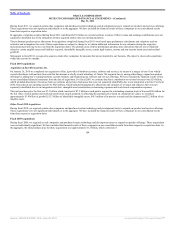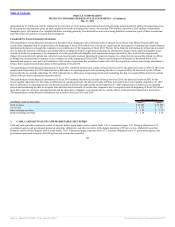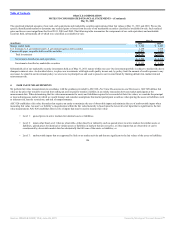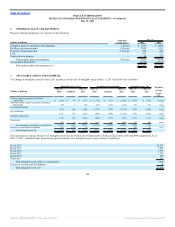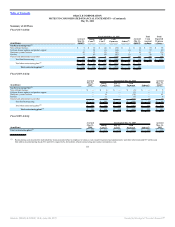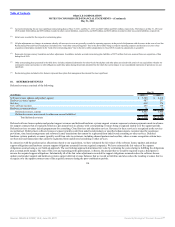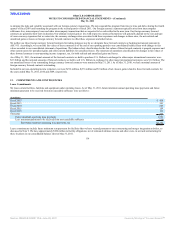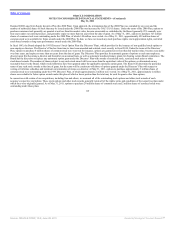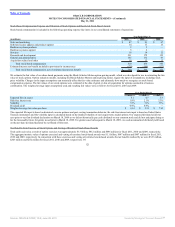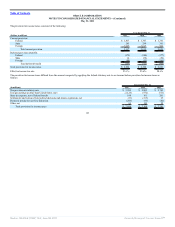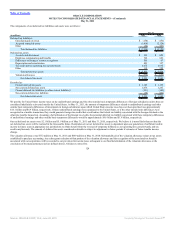Oracle 2010 Annual Report Download - page 118
Download and view the complete annual report
Please find page 118 of the 2010 Oracle annual report below. You can navigate through the pages in the report by either clicking on the pages listed below, or by using the keyword search tool below to find specific information within the annual report.
Table of Contents
ORACLE CORPORATION
NOTES TO CONSOLIDATED FINANCIAL STATEMENTS—(Continued)
May 31, 2011
(2) Accrued restructuring for our most significant restructuring plans at May 31, 2011 and May 31, 2010 was $449 million and $546 million, respectively. The balances at May 31, 2011 and
2010 include $244 million and $290 million recorded in other current liabilities, respectively, and $205 million and $256 million recorded in other non-current liabilities, respectively.
(3) Initial costs recorded for the respective restructuring plans.
(4) All plan adjustments are changes in estimates whereby all increases in costs are generally recorded to operating expenses in the period of adjustment with decreases in the costs of our Sun
Restructuring Plan and Oracle-based plans (included in the “total other restructuring plans” line in the above table) being recorded to operating expenses and decreases in costs of our
acquisition related plans (included in the “total other restructuring plans” line in the above table) adopted prior to fiscal 2010 recorded as adjustments to goodwill.
(5) Represents foreign currency translation and other adjustments. In addition, includes accrued restructuring plan liabilities of $275 million that were assumed from our acquisition of Sun
during fiscal 2010.
(6) Other restructuring plans presented in the table above include condensed information for other Oracle-based plans and other plans associated with certain of our acquisitions whereby we
continued to make cash outlays to settle obligations under these plans during the periods presented but for which the current impact to our consolidated statements of operations was not
significant.
(7) Restructuring plans included in this footnote represent those plans that management has deemed the most significant.
10. DEFERRED REVENUES
Deferred revenues consisted of the following:
May 31,
(in millions) 2011 2010
Software license updates and product support $ 5,386 $ 4,618
Hardware systems support 687 537
Services 438 376
New software licenses 263 330
Hardware systems products 28 39
Deferred revenues, current 6,802 5,900
Deferred revenues, non-current (in other non-current liabilities) 316 388
Total deferred revenues $ 7,118 $ 6,288
Deferred software license updates and product support revenues and deferred hardware systems support revenues represent customer payments made in advance
for support contracts that are typically billed on a per annum basis in advance with corresponding revenues being recognized ratably over the support periods.
Deferred services revenues include prepayments for consulting, Cloud Services and education services. Revenue for these services is recognized as the services
are performed. Deferred new software license revenues typically result from undelivered products or specified enhancements, customer specific acceptance
provisions, time based arrangements and software license transactions that cannot be segmented from undelivered consulting or other services. Deferred
hardware systems products revenues typically result from sales to customers, including channel partners and resellers, where revenue recognition criteria have
not been met and transactions that cannot be segmented from undelivered consulting or other services.
In connection with the purchase price allocations related to our acquisitions, we have estimated the fair values of the software license updates and product
support obligations and hardware systems support obligations assumed from our acquired companies. We have estimated the fair values of the support
obligations assumed using a cost build-up approach. The cost build-up approach determines fair value by estimating the costs relating to fulfilling the obligations
plus a normal profit margin. The sum of the costs and operating profit approximates, in theory, the amount that we would be required to pay a third party to
assume the acquired support obligations. Substantially all of the fair value adjustments recorded for support obligations assumed reduce the software license
updates and product support and hardware systems support deferred revenue balances that we record as liabilities and also reduce the resulting revenues that we
recognize over the support contract term of the acquired contracts during the post-combination periods.
114
Source: ORACLE CORP, 10-K, June 28, 2011 Powered by Morningstar® Document Research℠


